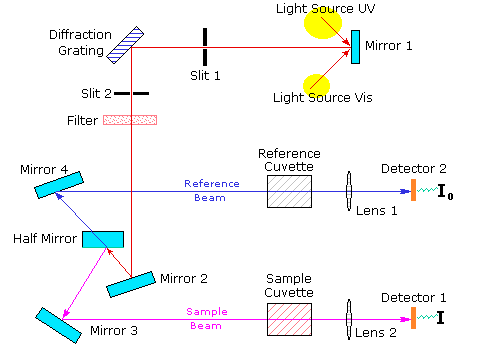1. It can be used to identify some functional groups in molecules and
2. It can be used for assaying. This second role – determining the content and strength of a substance – is extremely useful. Ultraviolet/visible spectroscopy is used extensively in chemical and biochemical laboratories, for a variety of tasks.
How to work UV/visible spectroscopy.

When light – either visible or ultraviolet – is absorbed by valence (outer) electrons these electrons are promoted from their normal (ground) states to
higher energy (excited) states . The energies of the orbitals involved in electronic transitions have fixed values. Because energy is quantised, it seems safe to assume that absorption peaks in a UV/visible.
The spectrometer
Samples are used in solution and are placed in a small silica cell. Two lamps are used. A hydrogen or deuterium lamp for the ultraviolet region and a tungsten/halogen lamp for the visible region. In this way radiation across the whole range is scanned by the spectrometer. A reference cell containing only solvent is used. Light is passed simultaneously through the sample cell
and reference cell. The spectrometer compares the light passing through the sample with that passing through the reference cell. The transmitted radiation
is detected and the spectrometer records the absorption spectrum by scanning the wavelength of the light passing through the cells.
Single beam instruments are now available as well as double beam instruments. Radiation across the whole range is monitored simultaneously. The principles are the same as for double beam instruments, but data on the reference are taken first, followed by the sample. In this way single beam instruments can record the spectrum very quickly.



nice blog about Spectrophotometer, i was looking for blogs related of Bio Spectrophotometer and Physics Lab Equipment Manufacturer , then i found your blog.
ReplyDeleteIt;s interested to read and having a nice information.